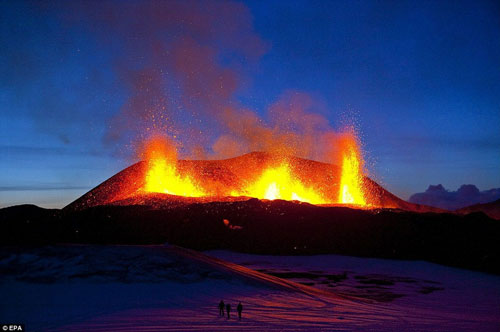Grindavik, Iceland
A volcano that spewed glowing red lava near Iceland’s capital Reykjavik after awakening for the first time in 900 years appeared to be subsiding on Saturday, experts said.
The eruption was small and did not represent a danger to people, officials said.
Dramatic first images filmed by a coast guard helicopter showed streams of red lava bubbling and flowing out of a fissure in a valley in Geldingadalur, close to Mount Fagradalsfjall on the Reykjanes peninsula in southwestern Iceland.
As the lava continued to flow less spectacularly under rain showers on Saturday, blue gas and a vapour cloud rose from the site, just 40 kilometres (25 miles) from the capital and near a popular tourist destination, the Blue Lagoon geothermal spa.
The eruption occurred on Friday around 2045 GMT, lighting up the night sky with a crimson glow as hundreds of small earthquakes shook the area.
While Iceland’s Keflavik International Airport and the small fishing port of Grindavik are just a few kilometres away, the zone is uninhabited and the eruption did not present any danger to the public.
“The eruption is considered small at this stage and the volcanic activity has somewhat decreased since yesterday evening,” the Icelandic Meteorological Office (IMO), which monitors seismic activity, said in a statement on Saturday.
It said the “eruptive fissure” measured approximately 500 to 700 metres (1,640 to 2,300 feet).
The lava area, it added, was less than one square kilometre (0.4 square mile), covering an area 500 metres wide, with small lava fountains.
Speaking to reporters, University of Iceland geophysicist Magnus Tumi Gudmundsson described the valley as an “ideal” spot for the eruption, likening it to “a bathtub the lava can slowly leak into.”
IMO earthquake hazards coordinator Kristin Jonsdottir meanwhile said it was “very likely the eruption will last for the next few days”, but could not definitively rule out a new eruption.
Friday’s eruption took place in the Krysuvik volcanic system, which does not have a central volcano, about five kilometres inland from the southern coast.
The vapour could be seen from Grindavik miles away, an AFP reporter said.
Sigurdur Kristmundsson, a 54-year-old Grindavik port official, told AFP locals were exhilarated by the eruption.
“Nobody is in danger or anything like that. So I think people are excited and not afraid of it.”
– Dormant for 900 years – Access to the area was initially blocked off but later opened to the public, though Iceland’s Department of Civil Protection and Emergency Management stressed the several-hour hike from the nearest road was only recommended for those “used to being outdoors in difficult conditions.—AFP










